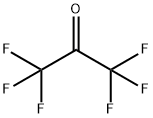Hexafluoroacetone

- CAS No.
- 684-16-2
- Chemical Name:
- Hexafluoroacetone
- Synonyms
- 1,1,1,3,3,3-hexafluoropropan-2-one;(CF3)2CO;6FK;gc7887;GC 7887;NCI-C56440;PERFLUOROACETONE;HEXAFLUOROACETONE;hexafluoro-aceton;Hexafluoropropanone
- CBNumber:
- CB2750815
- Molecular Formula:
- C3F6O
- Molecular Weight:
- 166.02
- MOL File:
- 684-16-2.mol
- Modify Date:
- 2024/12/18 14:08:52
| Melting point | −129 °C(lit.) |
|---|---|
| Boiling point | −26 °C(lit.) |
| Density | 1,32 g/cm3 |
| vapor density | 1.65 (vs air) |
| vapor pressure | 4525 mm Hg ( 21.1 °C) |
| storage temp. | Refrigerator |
| solubility | Chloroform |
| form | Colorless gas, which reacts vigorously with water to form hydrates |
| CAS DataBase Reference | 684-16-2(CAS DataBase Reference) |
| NIST Chemistry Reference | 2-Propanone, 1,1,1,3,3,3-hexafluoro-(684-16-2) |
| EPA Substance Registry System | Hexafluoroacetone (684-16-2) |
SAFETY
Risk and Safety Statements
| Symbol(GHS) |    GHS05,GHS04,GHS06 |
|---|---|
| Signal word | Danger |
| Hazard statements | H330-H314-H280 |
| Precautionary statements | P260-P264-P280-P301+P330+P331-P303+P361+P353-P363-P304+P340-P310-P321-P305+P351+P338-P405-P501-P410+P403-P260-P271-P284-P304+P340-P310-P320-P403+P233-P405-P501 |
| Hazard Codes | T |
| Risk Statements | 60-14-23/24/25-34-63 |
| Safety Statements | 53-26-28-36-45-7/9 |
| RIDADR | UN 2420 2.3 |
| OEB | C |
| OEL | TWA: 0.1 ppm (0.7 mg/m3) [skin] |
| WGK Germany | 3 |
| RTECS | UC2450000 |
| Hazard Note | Highly Toxic |
| TSCA | T |
| HazardClass | 2.3 |
| Hazardous Substances Data | 684-16-2(Hazardous Substances Data) |
| Toxicity | LD50 (mg/kg) in rats: 190 orally (trihydrate), 670 dermally (sesquihydrate); in mice: 250 i.p., 180 i.v.; in rabbits: 113 dermally (trihydrate) (Kennedy) |
| IDLA | 9 ppm (61 mg/m3) |
Hexafluoroacetone Chemical Properties,Uses,Production
Chemical Properties
Hexafluoroacetone is a colorless, nonflamma ble poison gas. Musty odor. Shipped as a liquefied com pressed gas.
Uses
Hexafluoroacetone is a protecting and activatng reagent used in the synthesis of (S)-isoserine from (S)-malic acid. It is also an intermediate used to prepare hexafluorocarbinols as liver X receptor-α agonists.
Definition
ChEBI: A ketone that is acetone in which all the methyl hydrogens are replaced by fluoro groups.
General Description
Hexafluoroacetone is a colorless, toxic, and highly reactive gas. At ambient temperatures, Hexafluoroacetone is likely to generate a considerable amount of vapor. Hexafluoroacetone is an irritant to skin, eyes and mucous membranes and is toxic by ingestion, skin absorption, and inhalation. When heated to high temperatures Hexafluoroacetone emits toxic fluoride fumes. Prolonged exposure of the container to fire or intense heat may cause Hexafluoroacetone to violently rupture and rocket. Hexafluoroacetone is used in the production of other chemicals.
Air & Water Reactions
Hygroscopic (i.e., absorbs moisture from the air); reacts with moisture to form a highly acidic sesquihydrate. .
Reactivity Profile
Hexafluoroacetone is incompatible with the following: Water, acids [Note: Hygroscopic (i.e., absorbs moisture from the air); reacts with moisture to form a highly acidic sesquihydrate.] .
Hazard
Toxic by inhalation and skin absorption. Reacts vigorously with water and other substances, releasing considerable heat. Nonflammable.
Health Hazard
TOXIC; may be fatal if inhaled, ingested or absorbed through skin. Vapors are extremely irritating and corrosive. Contact with gas or liquefied gas may cause burns, severe injury and/or frostbite. Fire will produce irritating, corrosive and/or toxic gases. Runoff from fire control may cause pollution.
Fire Hazard
Some may burn but none ignite readily. Vapors from liquefied gas are initially heavier than air and spread along ground. Some of these materials may react violently with water. Cylinders exposed to fire may vent and release toxic and/or corrosive gas through pressure relief devices. Containers may explode when heated. Ruptured cylinders may rocket.
Potential Exposure
Hexafluoroacetone is used as a chemi cal intermediate. A gas at room temperature, it forms vari ous hydrates with water which are used as solvents for resins and polymers. Other derivatives are used to make water repellent coatings for textiles and also to produce polymers.
Shipping
UN2420 Hexafluoroacetone, Hazard Class: 2.3; Labels: 2.3-Poisonous gas, 8-Corrosive material, Inhalation Hazard Zone B. Cylinders must be transported in a secure upright position, in a well-ventilated truck. Protect cylinder and labels from physical damage. The owner of the com pressed gas cylinder is the only entity allowed by federal law (49CFR) to transport and refill them. It is a violation of transportation regulations to refill compressed gas cylin ders without the express written permission of the owner.
Purification Methods
Dehydrate hexafluoroacetone by passing the vapours over P2O5. Ethylene is removed by passing the dried vapours through a tube containing Pyrex glass wool moistened with conc H2SO4. Further purification is by low temperature distillation using Warde-Le Roy stills. Store it in the dark at -78o. [Holmes & Kutschke Trans Faraday Soc 58 333 1962, Beilstein 1 IV 3215.]
Incompatibilities
Reacts with water, oxidizers, strong acids. Hygroscopic (i.e., absorbs moisture from the air); reacts with moisture to form a highly acidic sesquihydrate and considerable heat.
Waste Disposal
Return refillable compressed gas cylinders to supplier. Nonrefillable cylinders should be disposed of in accordance with local, state and federal regulations. Allow remaining gas to vent slowly into atmosphere in an unconfined area or exhaust hood. Refillable-type cylinders should be returned to original sup plier with any valve caps and outlet plugs secured and valve protection caps in place.
Hexafluoroacetone Preparation Products And Raw materials
684-16-2(Hexafluoroacetone)Related Search:
1of4
chevron_right




